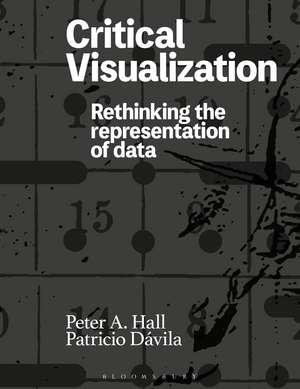Critical Visualization: Rethinking the Representation of Data
Autor Peter A. Hall, Patricio Dávilaen Limba Engleză Paperback – 28 dec 2022
| Toate formatele și edițiile | Preț | Express |
|---|---|---|
| Paperback (1) | 180.15 lei 3-5 săpt. | +54.42 lei 7-13 zile |
| Bloomsbury Publishing – 28 dec 2022 | 180.15 lei 3-5 săpt. | +54.42 lei 7-13 zile |
| Hardback (1) | 471.17 lei 3-5 săpt. | |
| Bloomsbury Publishing – 28 dec 2022 | 471.17 lei 3-5 săpt. |
Preț: 180.15 lei
Nou
Puncte Express: 270
Preț estimativ în valută:
34.47€ • 35.99$ • 28.53£
34.47€ • 35.99$ • 28.53£
Carte disponibilă
Livrare economică 15-29 martie
Livrare express 01-07 martie pentru 64.41 lei
Preluare comenzi: 021 569.72.76
Specificații
ISBN-13: 9781350077249
ISBN-10: 1350077240
Pagini: 256
Ilustrații: 100 colour illus
Dimensiuni: 189 x 246 x 16 mm
Greutate: 1.07 kg
Editura: Bloomsbury Publishing
Colecția Bloomsbury Visual Arts
Locul publicării:London, United Kingdom
ISBN-10: 1350077240
Pagini: 256
Ilustrații: 100 colour illus
Dimensiuni: 189 x 246 x 16 mm
Greutate: 1.07 kg
Editura: Bloomsbury Publishing
Colecția Bloomsbury Visual Arts
Locul publicării:London, United Kingdom
Caracteristici
Data visualisation is a hot topic, and this book takes a fresh approach, pointing out that information design is never a neutral practice.
Notă biografică
Peter A. Hall is Reader in Graphic Design at CCW, University of the Arts London, UK. His publications include Critical Visualization: Rethinking the Representation of Data, co-authored with Patricio Dávila (Bloomsbury, 2022), Sagmeister: Made You Look (2009), Else/Where: Mapping - New Cartographies of Networks and Territories, co-edited with Janet Abrams (2005) and Tibor Kalman: Perverse Optimist (2002).Patricio Dávila is a designer, artist, researcher and educator. He is Associate Professor in the Department of Cinema and Media Arts in the School of the Arts, Media, Performance and Design at York University, Canada. He is the editor of Diagrams of Power (2019) based on the international exhibition he curated on critical practice in mapping, and co-author, with Peter A. Hall, of Critical Visualization: Rethinking the Representation of Data (Bloomsbury, 2022).
Cuprins
1. An Introduction to Critical VisualizationDefining the fieldLooking at Visualization beyond Western ParadigmsAlternative Western perspectives: Distributed Cognition and Humanistic Approaches2. Disruptive HistoriesPositivism and ObjectivityA History of ProgressCritical Cartography: a 'Defining Moment'A Few Examples: Not a Canon- Haptic Visualization: the Quipu (1200-1532)- Plan and Sections of a Slave Ship (1789)- Polar Area Diagram (1859)- Great Trigonometrical Survey of India (1802-1875)- Data Visualization at the Paris Exposition, W.E.B. Du Bois (1900)- Community-building with Isotype: Otto and Marie NeurathConclusionFocus: Anna Ridler, Myriad (Tulips) 20183. Making DataQualitative and Quantitative DataThe Role of CategorizationFocus: Data4Change- Keepiton- Hear the Blind Spot- Perceiving Yemen4. Data and the SelfTaylorism Within?Comic CritiqueWhat is Normal?Biometrics and Risk-ProfilingChallenging NormsThe Examined LifeFocus: Margaret Pearce and Michael Hermann, They Would Not Take Me There: People, Places, and Stories from Champlain's Travels in Canada, 1603-16165. Data and the CityParticipatory planning: HECTORFocus: Heath Bunting: Status Project6. Aesthetics and RepresentationAesthetics and RepresentationRepresentation as Translation7. Beyond Critical Visualization Practice
Recenzii
Debunking the idea that data is ever 'raw' or unbiased, this book brings information anxiety to a new level as it goes deep into the underlying power structures at play in the assemblage of data and the motivations of those who amass it. Hall and Dávila explain how design's focus on clarity and statistical accuracy can serve to enhance dominant narratives inherent in the data and challenge designers to activate their agency to visualize the kind of world in which we want to live. This should be required reading in any data visualization or information design curriculum.
Hall and Dávila make a compelling argument for a critical approach to data visualization. Through a comprehensive survey of extant literature, a rereading of canonical images through decolonizing frameworks, and discussion of highly topical debates, they arrive at a rich examination of current projects drawn from a wide array of activities. They address self-quantification, smart cities, emotional cartography, and a whole host of specific and activist interventions in conventional data practices. Ultimately, they argue for visualizations that might create alternatives to dominant conventions and the oppressive power asymmetries of the status quo.
With acuity and depth, Hall and Dávila demonstrate just how much history, culture and context matter for the design and interpretation of data visualization. Their book is timely and important, and will usher in a new era of critical data practice.
Hall and Dávila make a compelling argument for a critical approach to data visualization. Through a comprehensive survey of extant literature, a rereading of canonical images through decolonizing frameworks, and discussion of highly topical debates, they arrive at a rich examination of current projects drawn from a wide array of activities. They address self-quantification, smart cities, emotional cartography, and a whole host of specific and activist interventions in conventional data practices. Ultimately, they argue for visualizations that might create alternatives to dominant conventions and the oppressive power asymmetries of the status quo.
With acuity and depth, Hall and Dávila demonstrate just how much history, culture and context matter for the design and interpretation of data visualization. Their book is timely and important, and will usher in a new era of critical data practice.
